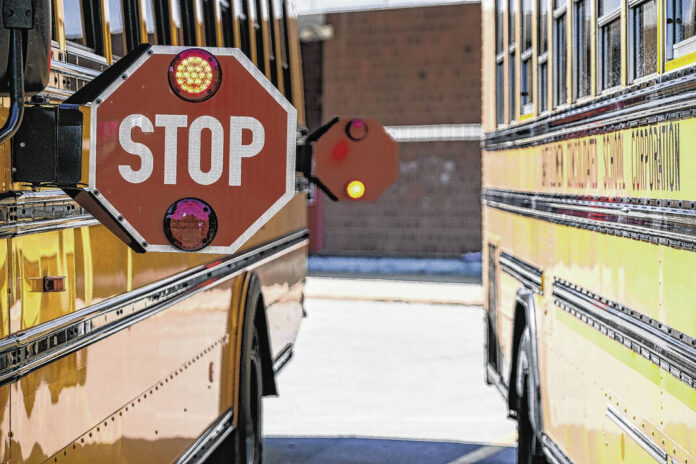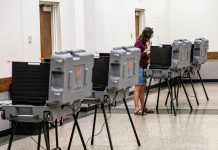
Mike Wolanin | The Republic The stop arms on a school bus are extended on a bus in the bus lot at Columbus East High School for a remembrance ceremony for Columbus East student Lily Streeval in Columbus, Ind., Thursday, Sept. 2, 2021.
School bus stop arm violations continue to be a major safety issue in the community, Bartholomew Consolidated School Corp.’s transportation department officials told school board members.
“We did a very big upgrade over the summer for stop arm cameras to help eliminate drivers running the stop arms while the buses are picking up the children every day,” said Director of Transportation AJ McKeand told the school board on Monday. “As of now — this was put out in August, when we started the school year — we’ve had 60 plus tickets issued, and this number goes up daily.”
He added that the school corporation has had to hire an additional employee to deal with the increasing number of violations.
In Indiana, it is illegal for motorists to pass a bus that is stopped, with red lights flashing and the stop arm extended.
This applies on all roads, with the exception of highways divided by a barrier, such as a cable barrier, concrete wall or grassy median — drivers on those roads only have to stop if traveling in the same direction as the school bus.
McKeand said that there has been a “learning curve” for transportation employees, as the stop camera system records the entire stop, and violations cannot be submitted in instances where there the bus driver did not complete their stop properly. One such instance would be if the bus driver did not come to a complete stop before extending their stop arm.
“So it’s kind of been a bit of a training issue on our end, but it’s worked out really well,” said McKeand. “And Officer Q (School Resource Officer Sgt. Julie Quesenbery) has got her work cut out for her. We’ve actually had so many violations that we’ve had to actually hire somebody else to just deal with stop arm violations, and that’s what she does every day.”
When asked if there were higher numbers of violations in the county or city, Quesenbery said there doesn’t seem to be much of a difference. The incidents are “sporadic” and occur in both the city and county, and she hasn’t seen any hotspots emerge. However, she is monitoring the location data and hopes to find trends that will aid with enforcement.
She is also not seeing a trend in regards to violations on four-lane roads versus those with two lanes.
In discussing stop arm violations, Quesenbery said that there’s no way to tell whether there’s a higher or lower number of violations this year than in years past, as the school corporation wasn’t equipped with the same range of technology that it is now.
“I hope we see a decrease,” she said. “I hope that people know that, hey, you’re going to get a citation for these things, even if you don’t get caught in the moment. So I hope that this number comes down in the years to come. Of course, that’s everyone’s hope. What would be the point, otherwise?”
Brett Boezeman, BCSC’s director of operations, said BCSC is constantly reviewing and improving safety procedures on school buses, particularly when it involves loading and unloading students.
“Most efforts are made in terms of training of staff, but some include the incorporation of additional hardware such as 360 cameras. These improvements are not reflective or reactive of specific events, he said.
In regards to changing bus routes to decrease situations where students have to cross two lanes of traffic, Boezeman said that this is something BCSC has done for several years and added that the school corporation follows state law, which doesn’t allow students to cross highways. The school corporation also constantly reviews routes and adjusts as needed for student safety, he said.
McKeand said that BCSC’s 12 new school buses also have collision avoidance systems, which can take control of buses and brake to avoid rear-end collisions. The system can also tell a bus driver the speed of the vehicle in front of them and has rollover control as well.
The BCSC transportation department’s report to the school board came just a few days after the sentencing of Shiam Sunder Shankara Subramanian, who was found guilty on two felony counts in the death of 16-year-old Columbus East High School student Lilly J. Streeval on Aug. 30, 2021. She was hit by the defendant’s car while trying to get on a school bus on South Gladstone Avenue, investigators said.
Bartholomew Circuit Judge Kelly Benjamin ordered the defendant to serve six years in prison for leaving the scene of an accident resulting in death or catastrophic injury, a Level 4 felony. Two of those years would be served on probation, she said.
She also sentenced Subramanian to three years in prison for passing a school bus while the arm signal is extended causing death, a Level 5 felony. But that sentence was ordered to be served concurrently (at the same time) as the first sentence.
The judge also said it is likely that Subramanian will be deported back to India once he completes his sentence.
A civil lawsuit filed by the victim’s mother, Teresa Burbrink, over her daughter’s death is pending.




